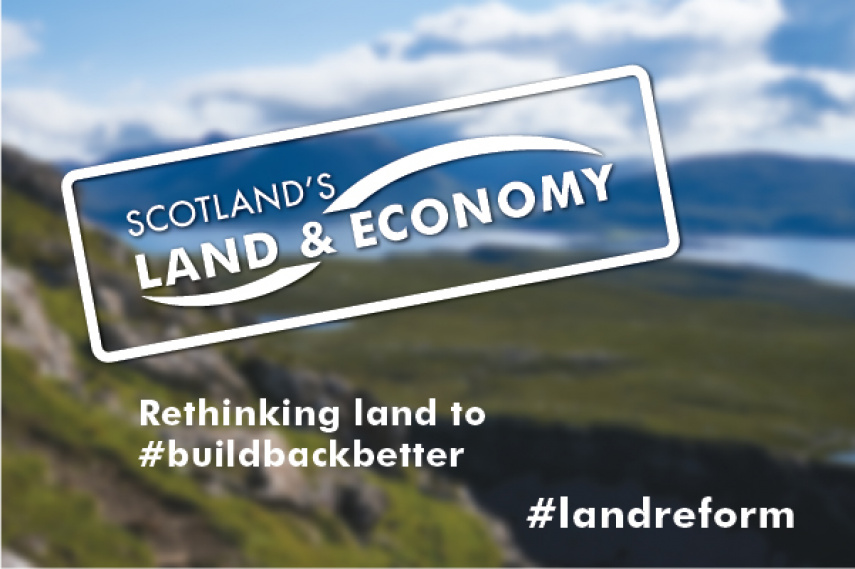
Putting land back into the economic model
Shona Glenn

The next blog in our ‘Scotland’s Land & Economy’ series, exploring the fundamental role of land in achieving Scotland’s post-pandemic recovery and renewal: Head of Policy at the Scottish Land Commission, Shona Glenn, looks at how we can make the economy work better by putting land back into the model.
If the Covid-19 pandemic has confirmed one thing it is that Scotland’s economic model is not working. It has given us increasing inequality, deep social divisions and a depleted natural environment.
The social and environmental consequences of this are clear but the costs to productivity and efficiency are no less severe.
The causal links between inequality and sub-optimal economic growth are now well established and there is clear evidence that unmitigated climate change would wreak havoc on the global economy.
It doesn’t have to be this way. Many people agree that it is time for change and are taking action.
Change will require us to reinvent our economic model so it prioritises wellbeing. Changing how we think about land could help us to do this.
For much of the past four decades land has been largely absent from our economic thinking. Where classical economics identifies three factors of production: land, labour and capital – the neoliberal model focuses on just two: labour and capital.
This matters for three main reasons.
Location, Location, Location
Firstly, land has a spatial dimension that the other factors of production lack. Locational characteristics – like access to infrastructure, proximity to amenities and a good view – all vary from site to site. Every piece of land is unique.
Uniqueness confers scarcity, a characteristic associated with monopoly power and the ability to earn returns above and beyond what would be possible in a competitive market. From an economic perspective this is fundamentally inefficient.
The potential for super-normal returns has been an important driver of rising inequality over the past few decades. It is not a coincidence that over 50% of the UK’s wealth is now held in land. But it also helps to explain Scotland’s relatively low levels of productivity.
When wealth is locked up in land it is not being invested in more productive assets and when it is possible to turn a profit simply through owning a piece of real estate – where is the incentive for innovation?
Innovation drives economic progress – so if we want to fix our economy we need to rebalance it so less is locked up in land.
The looming crisis facing the commercial property sector as a result of Covid-19 presents us with an opportunity to do this. We could, for example, use it to build a publicly owned portfolio of land and property that can be owned and managed to the benefit of local communities. Reinventing Common Good for the 21st century.
Production vs Capital Investment
Another reason for putting land back in our economic model is that this is the key to realising the elusive goal of 'sustainable development'.
Why? Because land – or more specifically the ecosystem services it provides – is the foundation for all economic production. From the food on our plates and the insects that pollinate our crops to the timber we use to build homes and the natural landscapes that support our wellbeing – our entire economy is sustained by the services provided by nature. But these services are largely ignored by our current model.
Changing this will require a major shift in thinking. We will need to stop focusing exclusively on current production (GDP) and start thinking more how we maintain future wellbeing. This will require a new emphasis on capital stocks – natural, human and manmade – and new tools for measuring progress that prioritise wellbeing.
Scotland’s legacy of vacant and derelict land – much of it in public ownership – presents one opportunity where immediate action is possible.
For example, a national green infrastructure investment programme focused on the transformation of derelict urban spaces. This would enable us to rebuild the resilience of Scotland’s most disadvantaged communities through the physical transformation of our most neglected public places – simultaneously addressing the twin challenges of our time: inequality and climate change.
Doing this could also help respond to the significant increase in unemployment many people fear is likely over the coming months: using public investment to create training and employment opportunities in the creation of a national network of green infrastructure.
From Market Failure to Value Creation
The third reason for putting land back into our economic model is a practical one: land provides a physical focus for action.
For too long we have been relying solely on the private sector to drive the physical renewal of our public places. This approach has demonstrably failed many parts of Scotland leaving us with a legacy of post-industrial decline that has remained largely unchanged for decades.
If we want to avoid creating a new legacy of post-Covid urban dereliction, then the state must do more than simply address market failure – it can act to proactively create value.
This implies a much more proactive role for public bodies in initiating and driving major development, particularly in parts of Scotland where the market is reluctant to operate.
To do this we need to be willing to rethink how our tax system operates and how we incentivise landowners to repurpose surplus commercial property in ways that will support societal wellbeing. We need to make sure our planning policies and regulatory frameworks are agile enough to support structural transition and we need to find more effective ways of pooling the resources and expertise across the public sector in service of effective delivery.
Land can provide a tangible focus for all of this.